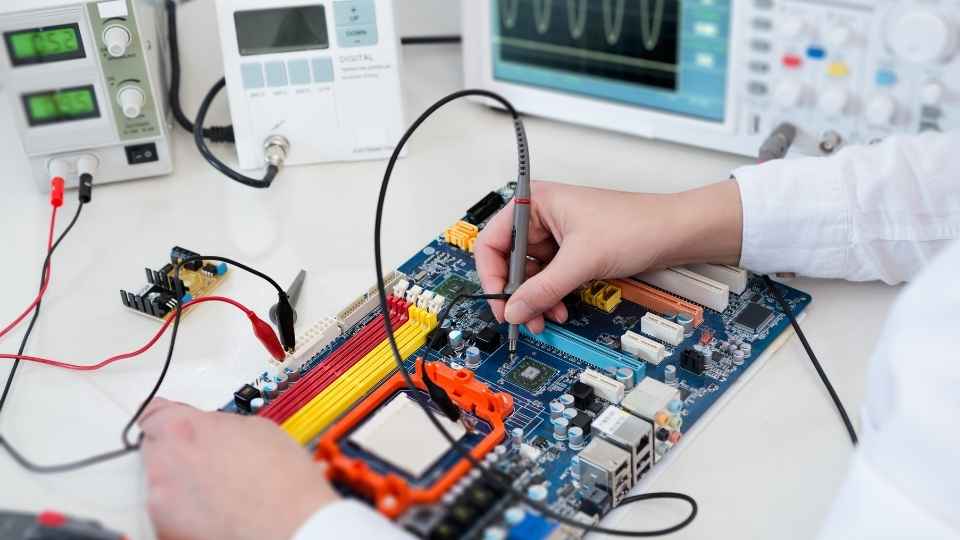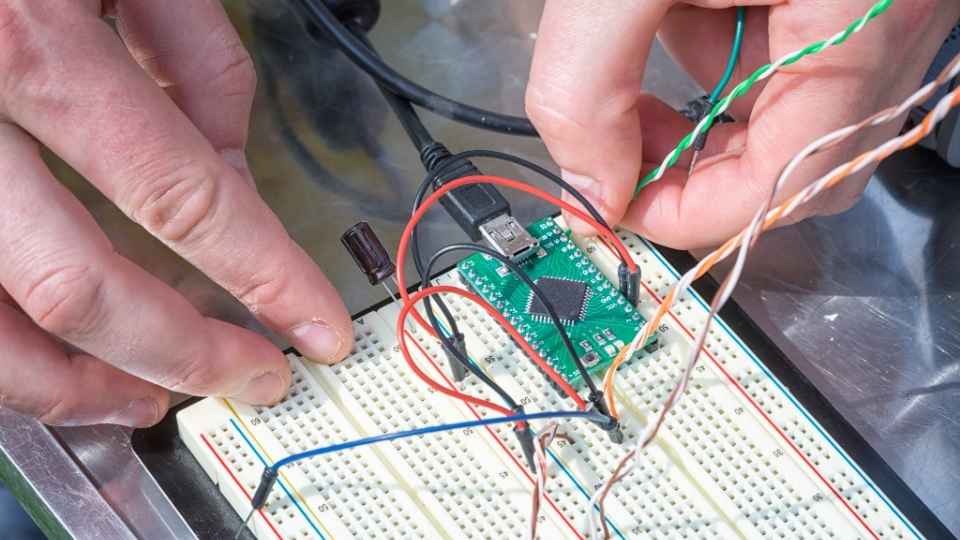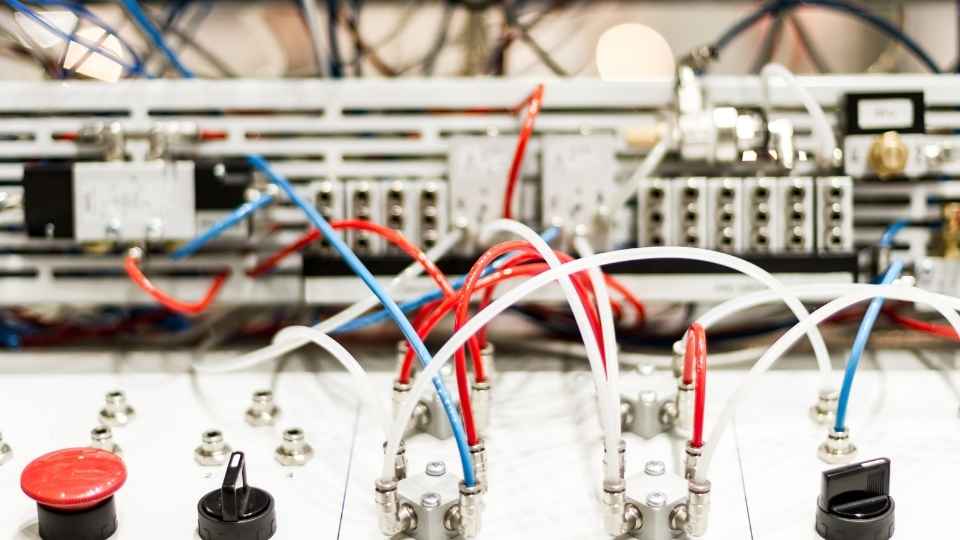
Are you intrigued by the inner workings of electronic devices? Do you wish to gain a comprehensive understanding of the fundamental components that make up these devices?
Look no further, as this article aims to provide you with a detailed exploration of basic electronics components. From resistors and capacitors to diodes and transistors, we will unravel the mysteries behind their functionality.
Join us on this technical journey as we delve into the intricate world of electronics and discover its practical applications.
Key Takeaways
- Electronics components are crucial for the functioning and design of electronic devices.
- Understanding components is essential for troubleshooting and circuit design.
- Resistors, capacitors, transistors, and integrated circuits each have unique functionality and characteristics.
- Manipulating resistance values allows engineers to control current flow.
The Importance of Understanding Electronics Components
It is imperative for individuals working in the field of electronics to have a thorough understanding of various components as they play a crucial role in the functioning and design of electronic devices. Electronics components are the building blocks that make up any electronic circuit, and without a proper understanding of these components, it would be challenging to troubleshoot or design circuits effectively.
Components such as resistors, capacitors, transistors, and integrated circuits each have their own unique functionality and characteristics that must be understood to ensure optimal performance. By comprehending how these components interact with one another and with external signals, engineers can create innovative designs that meet specific requirements.
In this section, we will explore the functionality of resistors and how they contribute to the overall operation of an electronic circuit.
Exploring the Functionality of Resistors
Resistors play a crucial role in electrical circuits by providing resistance to the flow of electric current. Understanding their functionality is essential for designing and analyzing circuits.

Exploring the functionality of resistors involves learning about their resistance values, which are indicated by a color coding system. This system allows engineers and technicians to quickly identify the resistance value of a resistor by examining the bands of color on its body.
Additionally, there are different types of resistors available for various applications. Some common types include carbon composition resistors, metal film resistors, and wirewound resistors. Each type has its own advantages and disadvantages, making them suitable for different circuit designs and environments.
Resistance in Circuits
Resistance plays a crucial role in determining the flow of current through a circuit. It is the property that opposes the movement of electrons and converts electrical energy into heat. Resistance is measured in ohms (Ω) and is denoted by the symbol R.
In a circuit, resistance restricts the amount of current that can flow through it. Ohm's Law states that the current flowing through a conductor is directly proportional to the voltage across it and inversely proportional to its resistance. This relationship can be expressed as I = V/R, where I represents current, V represents voltage, and R represents resistance.
Understanding resistance is essential for designing efficient circuits and ensuring proper functionality of electronic devices. By manipulating resistance values, engineers can control the flow of current to meet specific requirements.
Now let's explore how resistors are marked using a color coding system...
Color Coding System
The color coding system is a widely used method for identifying the values of resistors in electronic circuits. It provides a quick and efficient way to determine the resistance value without having to rely on complex calculations or measurements.

In this system, each color represents a specific numeric value, and by combining colors, the resistance value can be determined. The first band represents the first digit of the resistance value, while the second band represents the second digit.
The third band indicates the multiplier or power of 10 by which these digits should be multiplied. The fourth band (if present) denotes tolerance, indicating how much variation from the stated resistance value is acceptable.
Types of Resistors
There are several different types of resistors that can be used in electronic circuits, each with their own specific characteristics and applications.
The most common type is the fixed resistor, which has a constant resistance value that does not change with temperature or voltage.
Another type is the variable resistor, also known as a potentiometer or rheostat, which allows for adjustable resistance by varying the position of a slider or knob.
Precision resistors are designed to have very low tolerance levels and can maintain their accuracy over a wide range of temperatures and frequencies.
Power resistors are capable of handling high currents and dissipating large amounts of power without overheating.

Surface mount resistors are smaller in size and suitable for compact circuit designs.
Understanding the different types of resistors is essential for selecting the appropriate component based on the desired application requirements.
Unraveling the Mysteries of Capacitors
Capacitors, essential elements in electronic circuits, store and release electrical energy, playing a crucial role in various applications. These passive components consist of two conductive plates separated by an insulating material called dielectric. When a voltage is applied across the capacitor, it charges up and stores electrical energy in its electric field.
Capacitors are commonly used to filter out noise and stabilize voltages in power supplies, as well as to store energy for short-term power backup systems. They also serve as timing elements in oscillators and signal processing circuits. The capacitance value determines how much charge the capacitor can store for a given voltage.
Capacitors come in various types such as electrolytic capacitors for high capacitance values or ceramic capacitors for smaller values. Understanding these fundamental properties of capacitors allows engineers to design efficient and reliable electronic systems with the freedom to explore innovative solutions.
Decoding the Purpose of Diodes
Diodes are electronic components that allow current to flow only in one direction. They consist of a PN junction, which is formed by combining P-type and N-type semiconductors.
By utilizing this property, diodes serve various purposes such as rectifying AC signals into DC signals, protecting circuits from reverse voltage, regulating voltage levels, and generating light in LEDs.

Understanding the functionality and applications of diodes is crucial for comprehending the intricacies of electronic circuits.
Diode Functionality Explained
The functionality of a diode can be easily understood through its ability to allow current flow in only one direction while blocking it in the opposite direction. This property is crucial for many electronic applications, as it enables the control and manipulation of electrical currents.
Diodes are made up of two semiconductor materials, namely N-type and P-type materials, which create a junction between them. When a positive voltage is applied to the P-side and negative voltage to the N-side, this forward-biases the diode, allowing current to flow freely.
Conversely, when a reverse bias is applied with positive voltage on the N-side and negative voltage on the P-side, the diode acts as an insulator, preventing current flow entirely. Understanding this simple yet powerful behavior of diodes forms the foundation for countless electronic devices that rely on their unique capability to regulate electrical current based on its direction.
Applications of Diodes
Diodes play a crucial role in a wide range of electronic devices and systems due to their ability to control the flow of electrical current. These semiconductor devices allow current to flow freely in one direction while blocking it in the opposite direction. This unique characteristic makes diodes an essential component in various applications.
One common application of diodes is rectification, where they are used to convert alternating current (AC) into direct current (DC). By allowing only the positive or negative half-cycle of the AC signal to pass through, diodes ensure a unidirectional flow of current. This is particularly useful in power supplies and battery chargers.
Diodes also find extensive use in voltage regulation circuits. They can be employed as voltage clamps or limiters, preventing excessive voltages from damaging sensitive components by shunting away excess energy.

Another important application is signal modulation and demodulation. Diodes are used for amplitude modulation (AM) detection, frequency modulation (FM) generation, and demodulation processes.
In addition, diodes are utilized for protection against reverse polarity connections which could damage electrical equipment.
Overall, the versatility of diode applications makes them invaluable in electronic systems that desire freedom from unwanted currents or voltages while providing efficient control over electrical flow.
Delving Into the World of Transistors
Exploring the realm of transistors allows us to delve deeper into the intricate workings of electronic circuits. Transistors are semiconductor devices that amplify or switch electronic signals and are fundamental building blocks in modern electronics. They have revolutionized technology by enabling miniaturization, increased efficiency, and versatility.
Here are two key aspects to understand about transistors:
Types of transistors:
Bipolar Junction Transistor (BJT): These transistors have three layers of semiconductor material and can be either NPN or PNP type. They are commonly used for amplification.

Field Effect Transistor (FET): FETs use an electric field to control the flow of current through a channel. There are two types: MOSFETs, which have a metal gate, and JFETs, which have a junction gate.
Operating modes:
Cut-off mode: No current flows between collector and emitter terminals in this mode.
Saturation mode: Current freely flows between collector and emitter terminals when transistor is fully turned on.
Understanding these concepts provides freedom to design complex electronic systems with precision and efficiency.
Introduction to Simple Integrated Circuits (ICs
Integrated circuits (ICs) play a pivotal role in modern electronics. They combine multiple electronic components onto a single chip, resulting in compact and efficient circuitry. ICs have revolutionized the field of electronics by providing increased functionality and performance while reducing size and cost.
These tiny chips are made up of transistors, resistors, capacitors, and other electronic components that are interconnected using intricate patterns of metal conductors. The integration of these components on a single chip allows for complex functionalities such as amplification, filtering, and logic operations to be performed with ease.

ICs come in various types including analog, digital, mixed-signal, and microcontrollers to cater to different applications. They have become an essential component in our everyday lives, powering devices such as smartphones, computers, televisions, medical equipment, automotive systems, and more.
Their compactness and versatility enable the freedom to design innovative products that enhance our daily experiences.
Practical Applications of Basic Electronics Components
One of the key factors in designing practical electronic circuits is the careful selection and implementation of various electronic components. These components play a crucial role in defining the functionality and performance of the circuit.
Here are two sub-lists highlighting some practical applications of basic electronics components:
Resistors:
Voltage division: Resistors are commonly used to divide voltage levels, allowing for precise control over signal strength.
Current limiting: By placing resistors in series with other components, current flow can be restricted to protect sensitive devices.

Capacitors:
Filtering noise: Capacitors are often used to filter out unwanted noise by blocking high-frequency signals.
Energy storage: Capacitors can store electrical energy and release it when needed, making them useful in power backup systems.
Frequently Asked Questions
What Is the Difference Between a Resistor and a Capacitor?
A resistor and a capacitor are two fundamental components in electronics. While a resistor restricts the flow of electric current, a capacitor stores electrical energy temporarily. They have different properties and functions in electronic circuits.
Can Diodes Be Used as Amplifiers?
Diodes can be used as amplifiers in certain configurations, such as the common-emitter amplifier. However, their inherent nonlinear characteristics and limited gain make them less suitable compared to dedicated amplifier components like transistors.
How Do Transistors Work in Electronic Circuits?
Transistors are semiconductor devices used in electronic circuits to amplify and switch electrical signals. They consist of three layers of material, namely the emitter, base, and collector, which control the flow of current and voltage in a precise manner.
What Are Some Common Applications of Integrated Circuits (Ics)?
Integrated circuits (ICs) have numerous common applications in various electronic devices. They are used in computers, smartphones, televisions, automobiles, and medical equipment to perform functions such as processing data, amplifying signals, and controlling electrical systems efficiently and reliably.

How Can Basic Electronics Components Be Utilized in Everyday Life?
Basic electronics components, such as resistors, capacitors, and transistors, play a vital role in various everyday applications. They are essential for powering electronic devices, controlling electrical signals, and facilitating communication systems, among other uses.
 Basic Electronics ConceptsEssential ToolsCircuit Design BasicsMicrocontrollersDIY Electronics ProjectsRoboticsPrivacy PolicyTerms And Conditions
Basic Electronics ConceptsEssential ToolsCircuit Design BasicsMicrocontrollersDIY Electronics ProjectsRoboticsPrivacy PolicyTerms And Conditions
